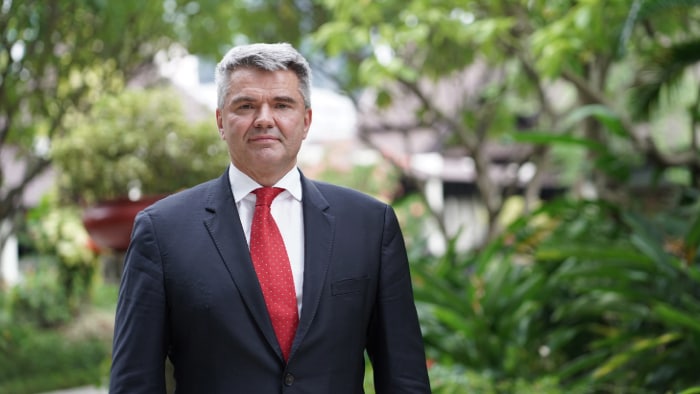Jakarta, Indonesia – Cardiovascular disease (CVD) remains one of the major global health challenges, claiming millions of lives each year. The COVID-19 pandemic has only worsened this crisis, leading to delayed care and contributing to higher mortality rates. According to the latest data from the Healthcare and Social Security Agency (BPJS Kesehatan), heart disease is the leading cause of death in Indonesia, with more than 20 million cases reported in 2023, marking an alarming 29% increase from the 15.5 million cases recorded in 2022. At the biggest cardiovascular intervention event in Indonesia, ISICAM 2024 (Indonesian Society of Interventional Cardiology Annual Meeting), we had the privilege of having a chat with Professor Dariusz Dudek, Professor of. Medicine and Cardiology at the Jagiellonian University, about the current state of cardiovascular care and patient outlooks in Indonesia.
1. What is a global trend in heart disease that concerns you the most?
A concerning trend in recent years sees CVD also affecting younger populations globally. The rising prevalence of CVD in younger adults is often linked to lifestyle, environmental factors, and genetics. Aside from managing the risks, it is crucial that cardiovascular diseases are effectively treated to help patients live longer. The good news is, today’s cardiovascular treatments and coronary interventions are improving, even in developing countries. Technology plays a key role in improving patient outcomes by providing better guidance during procedures, leading to better results.
2. What role does interventional cardiology – your specialty – play in caring for the heart?
Interventional cardiology is a subspecialty of cardiology that uses minimally invasive procedures to treat cardiovascular disease. It corrects two main problems that people have with their heart. The first type are coronary conditions such as coronary artery disease (CAD), coronary ischemia and heart attacks, and these are treated through procedures like interventional stenting (angioplasty) or, in worst case scenarios, with bypass surgery. The second condition involves elderly patients with valve disease, when their heart valve degenerates or weakens, requiring structural heart intervention. So in the field of interventional cardiology, it’s common to have 2 different types of interventional cardiologists on patient care teams – one for coronary interventions, another for structural heart interventions.

3. What are some of the latest innovations in interventional cardiology that excite you?
We now have innovative devices that really enhance diagnostic precision and optimize procedure outcomes. We have ultrasounds that allow us to see the insides of coronary vessels, that’s an imaging technique called intravascular ultrasound that’s being prioritized by the latest European Society of Cardiology (ESC) guidelines. We also now have pressure-sensing wires that can be inserted directly into the heart to measure blood pressure, and this allows us to assess how well arteries are functioning. All these advances in technology mean that we can see and understand much better into our arteries and have more precise guidance during heart procedures to get better patient outcomes. Not only that, these innovations reduce the radiation exposure of our patients and are also more automated. It’s exciting because what the literature and scientific data shows is that these innovations help our patients survive cardiovascular events, live longer and live well.
4. How have Philips innovations in this field benefited you and your patients?
In my elderly, fragile and high-risk patients, such as those with chronic kidney disease, heart failure or cardiogenic shock, there is always a concern about using too much contrast agent during diagnostic imaging. Contrast agents are substances used during medical imaging to enhance the visibility and detail of specific areas in the heart – such as tissue or other structures. However, excessive use of contrast can harm kidney or heart function, so it’s better to minimize their use. Technology that allows me to obtain high-quality images, conduct precise planning and stenting, with less contrast required, allows me to treat even the most challenging or difficult patients more effectively.
Technology that allows me to obtain high-quality images, conduct precise planning and stenting, with less contrast required, allows me to treat even the most challenging or difficult patients more effectively
Prof. Dariusz Dudek
Interventional Cardiologist and Professor of Medicine and Cardiology, Jagiellonian University
5. How does Philips ULC-PCI support interventionists in treating their patients?
Philips ultra-low contrast PCI (ULC-PCI) is another breakthrough innovation that allows interventionists to perform procedures with reduced contrast media, while maintaining greater confidence and clarity. This technology combines real-time fluoroscopy with blood flow measurements and intravascular ultrasound (IVUS), helping interventionists diagnose, decide, guide, treat, and confirm PCI success. Philips ULC-PCI seamlessly integrates with Azurion Image-Guided Therapy, reducing the use of contrast media in PCI procedures. For me, this technology is very helpful for specific patients who require low-contrast procedures. It allows more imaging without contrast, reducing the need for excessive contrast media and X-ray. That’s why the full integration of the system provides a lot of opportunities to treat even the most challenging and difficult cases without extensive use of contrast or radiation.
6. How do you see interventional cardiology evolving in the next decade?
Meetings like ISICAM are crucial, because cardiologists from all over the world can come together to share their experience, expertise and best practices. It is through such knowledge exchanges that we continuously learn how to improve our techniques, how to solve difficult situations and better plan and approach complex procedures and patients. Better patient outcomes and treatment quality in this field relies heavily on advanced imaging technology, higher image resolutions, easier workflows and the seamless integration of multiple devices. These innovations make it easier for cardiologists like ourselves to work more efficiently and deliver optimal care in less time. Whilst current practice revolves around reactive, acute care, prevention is always better than cure. In the future, we will see a heavier focus on preventive and predictive care for early intervention. We will want to be predicting coronary risks before they happen, by detecting e.g. non-critical lesions, plaque in the arteries etc. supported by high-quality diagnostic imaging and artificial intelligence. This will in turn allow for early interventions, such as prescribing medication to prevent diseases like CAD from escalating to heart attacks. The field of interventional cardiology must rapidly evolve, given the aging population and the increasing prevalence of CVD across all age brackets. I truly hope that precision cardiology—shifting from reactive care to proactive prevention – will continue to rapidly expand and become the new standard in managing CVD. I believe improving the quality of life, especially for heart disease patients, is of utmost importance. To move toward seamless care together, we must continue to break down the barriers between departments and specialists, create breakthrough innovations, eliminate the obstacles separating patients and caregivers, and bridge the gaps that exist between healthcare settings and peoples’ homes. Because today, health knows no bounds.
Share on social media
Topics
Contact

Tan Yi Xian Communications and Brand Manager, ASEAN
You are about to visit a Philips global content page
Continue









